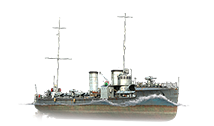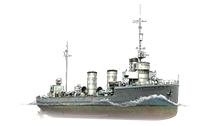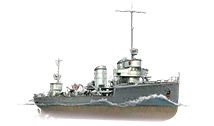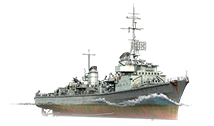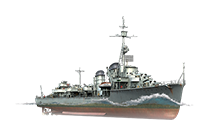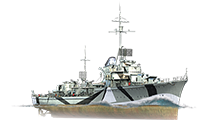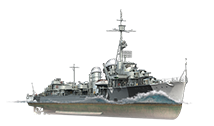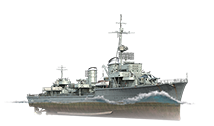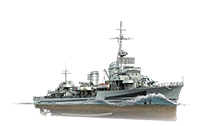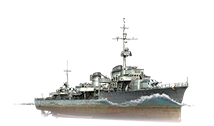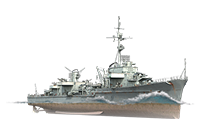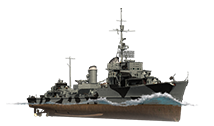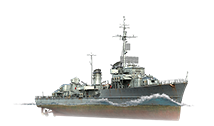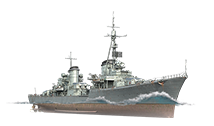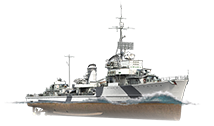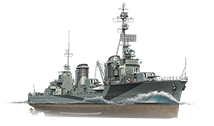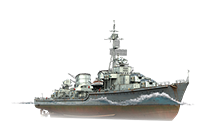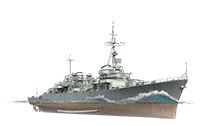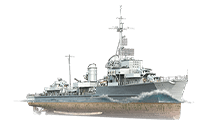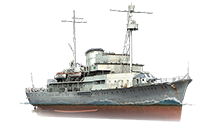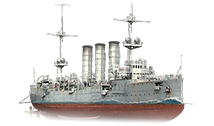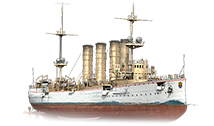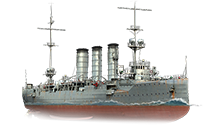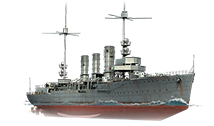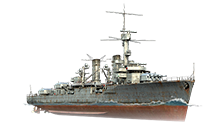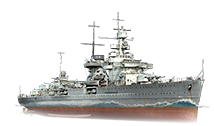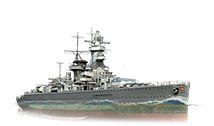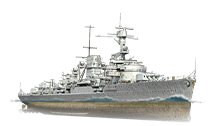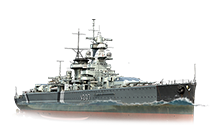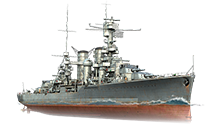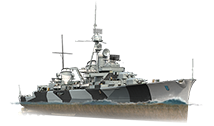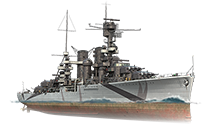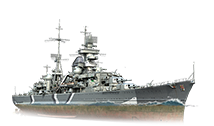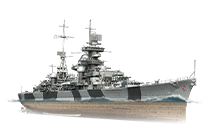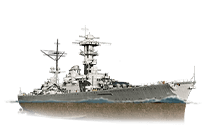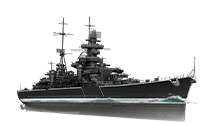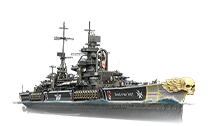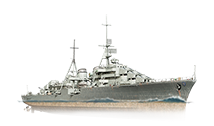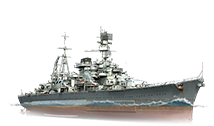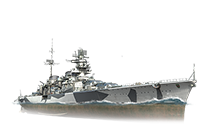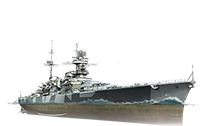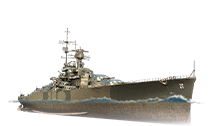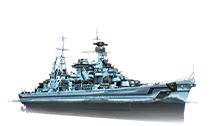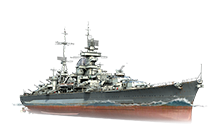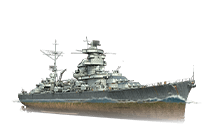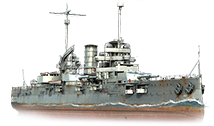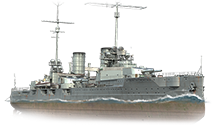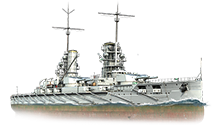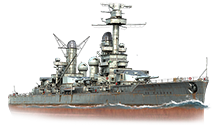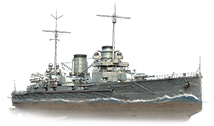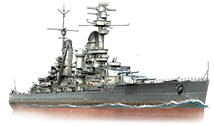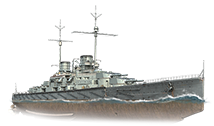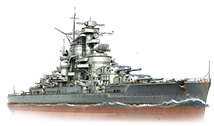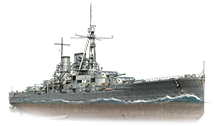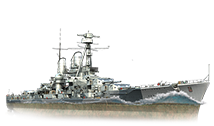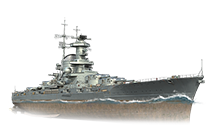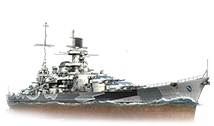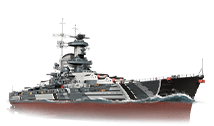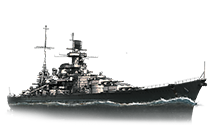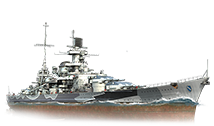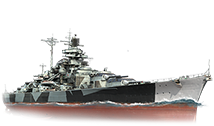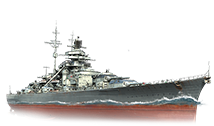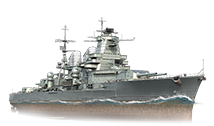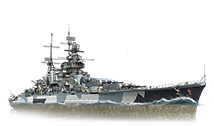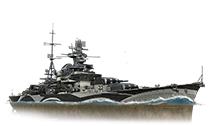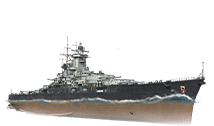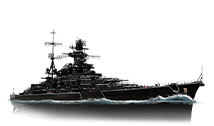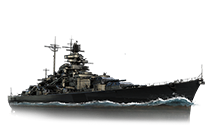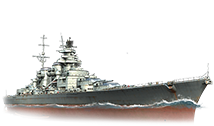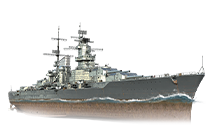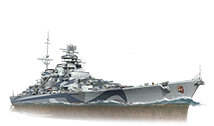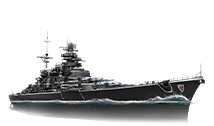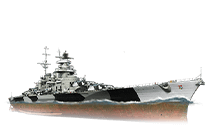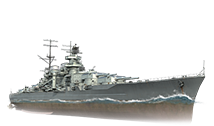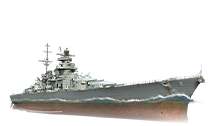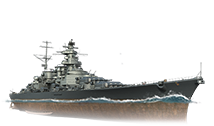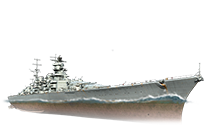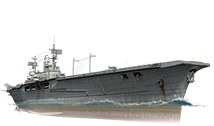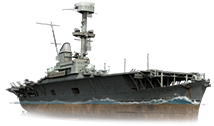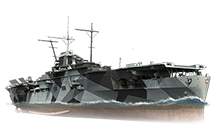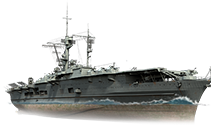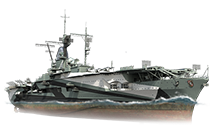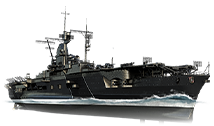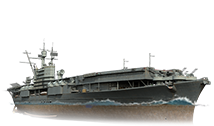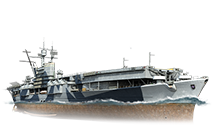| Revision as of 13:32, 27 September 2017 | | Revision as of 20:11, 27 September 2017 |
| Line 9: | | Line 9: |
| | ===Destroyers=== | | | ===Destroyers=== |
| | ====Gameplay==== | | | ====Gameplay==== |
| ? | [[Image:Ship_PGSD108_Z_23.png|frame|right|link=Ship:Z-23|''Z-23'', Tier VIII destroyer]]German [[ship_types_destroyer|destroyers]] offer a mix in playstyles. A captain who enjoys Russian destroyers will enjoy the primary gun handling. Fans of Japanese destroyers will enjoy their fast-reloading torpedoes. And American destroyer captains will find themselves in one of the best capture point destroyers available. The early tiers encourage aggressive play with forward-firing torpedo arcs all the way to Tier IV. Charge an enemy battleship with {{Engine Boost}}, change course to fire both front torpedoes, close to point-blank range, turn and unload. Unlike American destroyers, German {{Smoke Generator}} consumables do not last as long, so they are mainly used as a defensive measure. The Tier V [[ship:T-22|''T-22'']] loses the forward-facing torpedo arcs and serves as a transition from the low tier destroyers to the high tier. Things get interesting at Tier VI with the [[ship:Ernst_Gaede|''Ernst Gaede'']], as it adds one more tool to the German captain's arsenal: {{Hydroacoustic Search}}. Now the hunted becomes the hunter, as German Destroyers from Tier VI and above are able to charge an enemy smoke cloud, activate {{Hydroacoustic Search}}, and spot incoming torpedoes and the enemy ship itself. Enemy destroyers are no longer safe remaining in their smoke cloud on a capture point. Kill them or drive them off and capture the point! {{Hydroacoustic Search}} also enables German destroyers to screen ahead of the fleet and locate incoming torpedoes aimed at friendly battleships. To mix things up, both the Tier VI [[ship:Ernst_Gaede|''Ernst Gaede'']] and the Tier VIII [[ship:Z-23|''Z-23'']] allow for 150mm guns. These guns, coupled with strong [[Ship:Gunnery_%26_Armor_Penetration#Armor-Piercing|armor-piercing]] shells, enable the experienced German captain to citadel broadside cruisers. This destroyer line does have some drawbacks, however. These ships can be vulnerable to enemy aircraft spotting or attacking them. In addition, their wide hull makes it very easy for enemy cruisers and battleships to penetrate with [[Ship:Gunnery_%26_Armor_Penetration#Armor-Piercing|armor-piercing]] shells, doing more damage than expected. A German destroyer captain must keep these weaknesses in mind when operating in a battle. Teamwork is of the utmost importance! | | + | [[Image:Ship_PGSD107_Leberecht_Maass.png|frame|right|link=Ship:Leberecht Maass|''Leberecht Maass'', Tier VII destroyer]]German [[ship_types_destroyer|destroyers]] offer a mix in playstyles. A captain who enjoys Russian destroyers will enjoy the primary gun handling. Fans of Japanese destroyers will enjoy their fast-reloading torpedoes. And American destroyer captains will find themselves in one of the best capture point destroyers available. The early tiers encourage aggressive play with forward-firing torpedo arcs all the way to Tier IV. Charge an enemy battleship with {{Engine Boost}}, change course to fire both front torpedoes, close to point-blank range, turn and unload. Unlike American destroyers, German {{Smoke Generator}} consumables do not last as long, so they are mainly used as a defensive measure. The Tier V [[ship:T-22|''T-22'']] loses the forward-facing torpedo arcs and serves as a transition from the low tier destroyers to the high tier. Things get interesting at Tier VI with the [[ship:Ernst_Gaede|''Ernst Gaede'']], as it adds one more tool to the German captain's arsenal: {{Hydroacoustic Search}}. Now the hunted becomes the hunter, as German Destroyers from Tier VI and above are able to charge an enemy smoke cloud, activate {{Hydroacoustic Search}}, and spot incoming torpedoes and the enemy ship itself. Enemy destroyers are no longer safe remaining in their smoke cloud on a capture point. Kill them or drive them off and capture the point! {{Hydroacoustic Search}} also enables German destroyers to screen ahead of the fleet and locate incoming torpedoes aimed at friendly battleships. To mix things up, both the Tier VI [[ship:Ernst_Gaede|''Ernst Gaede'']] and the Tier VIII [[ship:Z-23|''Z-23'']] allow for 150mm guns. These guns, coupled with strong [[Ship:Gunnery_%26_Armor_Penetration#Armor-Piercing|armor-piercing]] shells, enable the experienced German captain to citadel broadside cruisers. This destroyer line does have some drawbacks, however. These ships can be vulnerable to enemy aircraft spotting or attacking them. In addition, their wide hull makes it very easy for enemy cruisers and battleships to penetrate with [[Ship:Gunnery_%26_Armor_Penetration#Armor-Piercing|armor-piercing]] shells, doing more damage than expected. A German destroyer captain must keep these weaknesses in mind when operating in a battle. Teamwork is of the utmost importance! |
| | | | | |
| | ===Cruisers=== | | | ===Cruisers=== |
| | ====Gameplay==== | | | ====Gameplay==== |
| ? | [[Image:Ship_PGSC508_Prinz_Eugen.png|frame|right|link=Ship:Prinz_Eugen|''Prinz Eugen'', Tier VIII cruiser]]German [[Ship_types_cruiser|cruisers]] start off as lighter versions of their contemporaries, but as they progress up the tiers (especially past Tier VI), their true prowess is revealed: turrets that turn lightning-fast, housing guns that rapidly fire powerful [[Ship:Gunnery_%26_Armor_Penetration#Armor-Piercing|armor-piercing]] shells at long ranges, outranging both American and Japanese cruisers and even some battleships. Moreover, they commonly have the highest health values of their tier — allowing them to take a beating before going down — and their shells have reasonable firing arcs (i.e. no rainbow-like arcs such as those found on American destroyers and light cruisers) making gunnery very comfortable. Interestingly, their torpedoes from Tier V onwards are all exactly the same; do not underestimate them, however, for while a 6.0 km range is only marginally better than mid-tier American destroyers, at 64 knots German cruiser torpedoes are the fastest torpedoes mounted by any cruiser in the game until Tier IX Japanese cruiser ''[[Ibuki]]'' gets her upgraded torpedo module. Mid-tier German cruisers have mediocre anti-aircraft suites at best, but at Tier VIII and above they are loaded with a mix of long-range, high damage 40mm, 55mm, and 105mm guns that provide excellent AA protection for themselves and allied ships — particularly with the {{Defensive AA Fire}} consumable — and are frequently a source of frustration for enemy carrier captains. The downside is that German cruisers overall suffer from below average to average armor, poor concealment values, sub-par HE shell damage, and rather average speed and maneuverability. Starting at Tier IV, German cruisers have access to a superior version of the {{Hydroacoustic Search}} consumable. | | + | [[Image:Ship_PGSC108_Hipper.png|frame|right|link=Ship:Admiral Hipper|''Admiral Hipper'', Tier VIII cruiser]]German [[Ship_types_cruiser|cruisers]] start off as lighter versions of their contemporaries, but as they progress up the tiers (especially past Tier VI), their true prowess is revealed: turrets that turn lightning-fast, housing guns that rapidly fire powerful [[Ship:Gunnery_%26_Armor_Penetration#Armor-Piercing|armor-piercing]] shells at long ranges, outranging both American and Japanese cruisers and even some battleships. Moreover, they commonly have the highest health values of their tier — allowing them to take a beating before going down — and their shells have reasonable firing arcs (i.e. no rainbow-like arcs such as those found on American destroyers and light cruisers) making gunnery very comfortable. Interestingly, their torpedoes from Tier V onwards are all exactly the same; do not underestimate them, however, for while a 6.0 km range is only marginally better than mid-tier American destroyers, at 64 knots German cruiser torpedoes are the fastest torpedoes mounted by any cruiser in the game until Tier IX Japanese cruiser ''[[Ibuki]]'' gets her upgraded torpedo module. Mid-tier German cruisers have mediocre anti-aircraft suites at best, but at Tier VIII and above they are loaded with a mix of long-range, high damage 40mm, 55mm, and 105mm guns that provide excellent AA protection for themselves and allied ships — particularly with the {{Defensive AA Fire}} consumable — and are frequently a source of frustration for enemy carrier captains. The downside is that German cruisers overall suffer from below average to average armor, poor concealment values, sub-par HE shell damage, and rather average speed and maneuverability. Starting at Tier IV, German cruisers have access to a superior version of the {{Hydroacoustic Search}} consumable. |
| | | | | |
| | ===Battleships=== | | | ===Battleships=== |
| | ====Gameplay==== | | | ====Gameplay==== |
| ? | [[Image:Ship_PGSB002_Tirpiz_1942.png|frame|right|link=Ship:Tirpitz|''Tirpitz'', Tier VIII battleship]]German [[Ship_types_battleship|battleships]] exemplify their focus on designs and armor schemes capable of absorbing extraordinary amounts punishment and still remain afloat. Their main armament is often slightly smaller than their same-tier counterparts — though they reload quicker — and they frequently have more hit points and better armor, making them some of the most survivable battleships in the game. Their historical "turtleback" armor is modeled accurately in-game; they are more resilient the closer in they get to their enemies, though their armor schemes do leave them more vulnerable to long-range [[Ship:Gunnery_%26_Armor_Penetration#Armor-Piercing|plunging fire]]. These battleships feature heavy secondary armaments up-and-down the line, further rewarding players who are able to work into close-range brawls with enemy capital ships. Like their cruiser comrades, mid-to-high tier German battleships typically feature excellent long-range anti-aircraft firepower on the backs of their 105mm dual purpose batteries, but their AA doesn't continue to scale up the closer enemy planes get like [[Ship:Ships_of_U.S.A.|American battleship]] anti-aircraft firepower does. Though they feature quicker-than-average rudder shift times, they tend to have very large turning circles that make avoiding both ship and aerial torpedoes difficult. German battleships at Tier VIII and up receive access to the {{Hydroacoustic Search}} consumable to help alleviate this, but it is a constant threat that captains must keep in mind. | | + | [[Image:Ship_PGSB107_Gneisenau.png|frame|right|link=Ship:Gneisenau|''Gneisenau'', Tier VII battleship]]German [[Ship_types_battleship|battleships]] exemplify their focus on designs and armor schemes capable of absorbing extraordinary amounts punishment and still remain afloat. Their main armament is often slightly smaller than their same-tier counterparts — though they reload quicker — and they frequently have more hit points and better armor, making them some of the most survivable battleships in the game. Their historical "turtleback" armor is modeled accurately in-game; they are more resilient the closer in they get to their enemies, though their armor schemes do leave them more vulnerable to long-range [[Ship:Gunnery_%26_Armor_Penetration#Armor-Piercing|plunging fire]]. These battleships feature heavy secondary armaments up-and-down the line, further rewarding players who are able to work into close-range brawls with enemy capital ships. Like their cruiser comrades, mid-to-high tier German battleships typically feature excellent long-range anti-aircraft firepower on the backs of their 105mm dual purpose batteries, but their AA doesn't continue to scale up the closer enemy planes get like [[Ship:Ships_of_U.S.A.|American battleship]] anti-aircraft firepower does. Though they feature quicker-than-average rudder shift times, they tend to have very large turning circles that make avoiding both ship and aerial torpedoes difficult. German battleships at Tier VIII and up receive access to the {{Hydroacoustic Search}} consumable to help alleviate this, but it is a constant threat that captains must keep in mind. |
| | | | | |
| | | | | |
Throughout most of European history, Germany's naval prowess had always been eclipsed by its
British,
French, Dutch and Spanish neighbors. A unified Germany only came into being in the late 19th century, thus it did not play a major role in the European colonial period; while its inherited coastline (largely from the Kingdom of Prussia) was relatively long, Germany's geographical location at the center of the European continent meant that greater preference was given to its army and its navy never went beyond being a coastal defense force. Beginning in the late 19th century, Kaiser Wilhelm II pursued a policy of naval strengthening, believing that a powerful navy was the key to power on the world stage and possibly also wishing to compete with his cousin, King George V of Britain. While the meteoric rise of the Imperial German Navy caught the attention of Europe and brought about a costly naval arms race, it was never able to out-build and out-innovate the Royal Navy, who responded with powerful and revolutionary designs such as HMS
Dreadnought and the
Queen Elizabeth-class battleships. Nevertheless, the Imperial German Navy was a formidable force in World War I, being the first navy in the world to display the crippling effectiveness of submarines (despite technological limitations) against unescorted merchant shipping and slow, sluggish warships.
After her defeat, Germany once again set about attempting to challenge the Royal Navy with "Plan Z", but the earlier-than-expected outbreak of World War II meant that it could not be fully implemented, leaving her navy — now known as the Kriegsmarine — severely under-equipped to go toe-to-toe with the Royal Navy. This caused her surface fleet to be mostly relegated to operations support (such as Operation Weserübung, the invasion of Norway and Denmark) and commerce raiding. However, the Kriegsmarine had powerful (but very few) battleships and battlecruisers, scoring victories in sinking HMS Hood and HMS Glorious and putting up valiant, stubborn resistance — a testament to the crews' tenacity — until the superior numbers of British forces wore them down. As in World War I, more feared than her surface combatants were her fleet of U-boats; the largest, most powerful in the world and under the command of Grand Admiral Karl Dönitz — an experienced submariner himself who was instrumental in the buildup of the U-boat fleet after the scrapping of "Plan Z" — they wreaked havoc on British and American fleets and supply lines, sinking 14 million tons of shipping and more enemy warships than any other class throughout the war. Eventually, mounting losses inflicted by the Royal Navy resulted in the Kriegsmarine's surrender along with Germany on 8 May 1945, Victory in Europe (V-E) Day.
Destroyers
Gameplay
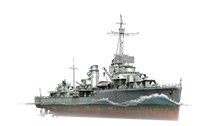
Leberecht Maass, Tier VII destroyer
German
destroyers offer a mix in playstyles. A captain who enjoys Russian destroyers will enjoy the primary gun handling. Fans of Japanese destroyers will enjoy their fast-reloading torpedoes. And American destroyer captains will find themselves in one of the best capture point destroyers available. The early tiers encourage aggressive play with forward-firing torpedo arcs all the way to Tier IV. Charge an enemy battleship with
Engine Boost 
, change course to fire both front torpedoes, close to point-blank range, turn and unload. Unlike American destroyers, German
Smoke Generator 
consumables do not last as long, so they are mainly used as a defensive measure. The Tier V
T-22 loses the forward-facing torpedo arcs and serves as a transition from the low tier destroyers to the high tier. Things get interesting at Tier VI with the
Ernst Gaede, as it adds one more tool to the German captain's arsenal:
Hydroacoustic Search 
. Now the hunted becomes the hunter, as German Destroyers from Tier VI and above are able to charge an enemy smoke cloud, activate
Hydroacoustic Search 
, and spot incoming torpedoes and the enemy ship itself. Enemy destroyers are no longer safe remaining in their smoke cloud on a capture point. Kill them or drive them off and capture the point!
Hydroacoustic Search 
also enables German destroyers to screen ahead of the fleet and locate incoming torpedoes aimed at friendly battleships. To mix things up, both the Tier VI
Ernst Gaede and the Tier VIII
Z-23 allow for 150mm guns. These guns, coupled with strong
armor-piercing shells, enable the experienced German captain to citadel broadside cruisers. This destroyer line does have some drawbacks, however. These ships can be vulnerable to enemy aircraft spotting or attacking them. In addition, their wide hull makes it very easy for enemy cruisers and battleships to penetrate with
armor-piercing shells, doing more damage than expected. A German destroyer captain must keep these weaknesses in mind when operating in a battle. Teamwork is of the utmost importance!
Cruisers
Gameplay
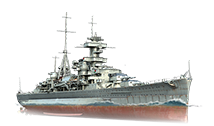
Admiral Hipper, Tier VIII cruiser
German
cruisers start off as lighter versions of their contemporaries, but as they progress up the tiers (especially past Tier VI), their true prowess is revealed: turrets that turn lightning-fast, housing guns that rapidly fire powerful
armor-piercing shells at long ranges, outranging both American and Japanese cruisers and even some battleships. Moreover, they commonly have the highest health values of their tier — allowing them to take a beating before going down — and their shells have reasonable firing arcs (i.e. no rainbow-like arcs such as those found on American destroyers and light cruisers) making gunnery very comfortable. Interestingly, their torpedoes from Tier V onwards are all exactly the same; do not underestimate them, however, for while a 6.0 km range is only marginally better than mid-tier American destroyers, at 64 knots German cruiser torpedoes are the fastest torpedoes mounted by any cruiser in the game until Tier IX Japanese cruiser
Ibuki gets her upgraded torpedo module. Mid-tier German cruisers have mediocre anti-aircraft suites at best, but at Tier VIII and above they are loaded with a mix of long-range, high damage 40mm, 55mm, and 105mm guns that provide excellent AA protection for themselves and allied ships — particularly with the
Defensive AA Fire 
consumable — and are frequently a source of frustration for enemy carrier captains. The downside is that German cruisers overall suffer from below average to average armor, poor concealment values, sub-par HE shell damage, and rather average speed and maneuverability. Starting at Tier IV, German cruisers have access to a superior version of the
Hydroacoustic Search 
consumable.
Battleships
Gameplay
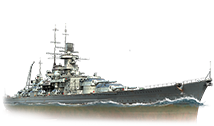
Gneisenau, Tier VII battleship
German
battleships exemplify their focus on designs and armor schemes capable of absorbing extraordinary amounts punishment and still remain afloat. Their main armament is often slightly smaller than their same-tier counterparts — though they reload quicker — and they frequently have more hit points and better armor, making them some of the most survivable battleships in the game. Their historical "turtleback" armor is modeled accurately in-game; they are more resilient the closer in they get to their enemies, though their armor schemes do leave them more vulnerable to long-range
plunging fire. These battleships feature heavy secondary armaments up-and-down the line, further rewarding players who are able to work into close-range brawls with enemy capital ships. Like their cruiser comrades, mid-to-high tier German battleships typically feature excellent long-range anti-aircraft firepower on the backs of their 105mm dual purpose batteries, but their AA doesn't continue to scale up the closer enemy planes get like
American battleship anti-aircraft firepower does. Though they feature quicker-than-average rudder shift times, they tend to have very large turning circles that make avoiding both ship and aerial torpedoes difficult. German battleships at Tier VIII and up receive access to the
Hydroacoustic Search 
consumable to help alleviate this, but it is a constant threat that captains must keep in mind.




